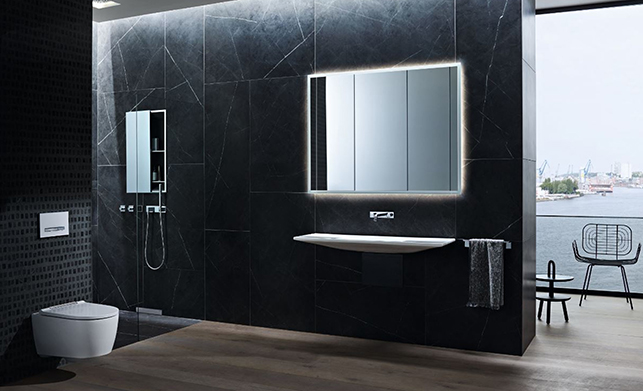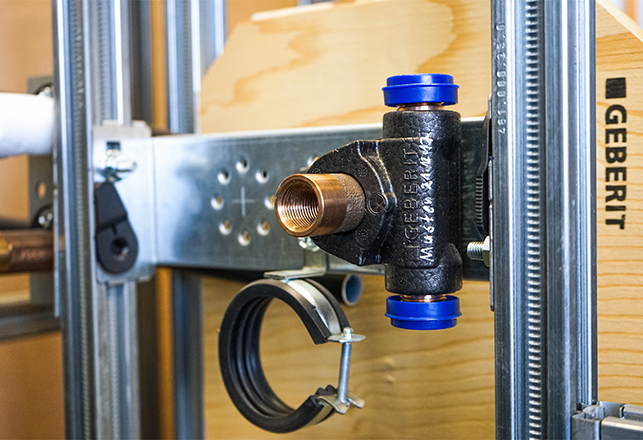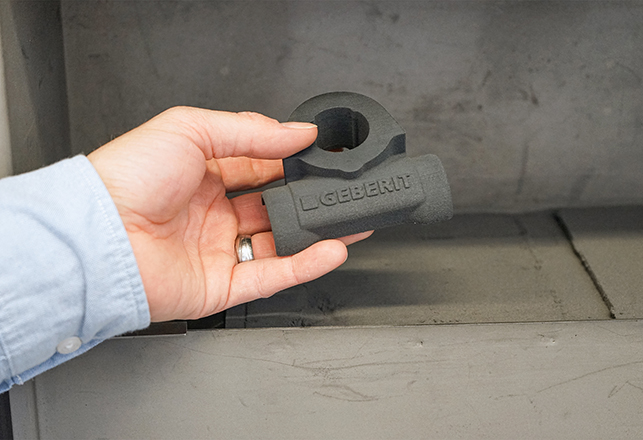
Geberit’s sanitary products span the ceramics and faucets that you see, to the important piping and valves hidden from view
The Geberit Group is responsible for a lot of bathrooms across Europe: a market leader for sanitary parts, it operates 29 production plants in over 50 countries, but getting parts to that stag is far from as clean a simple as the lines of its bathroom product ranges.
Before Geberit releases a new product for market launch it must meet a variety of requirements, with prototypes tested for quality, functionality, design and ease of assembly at the Group headquarters in Rapperswil-Jona, Switzerland.
As a result of the testing process each component will undergo several design variants before mass production, and it is within the prototyping lab that Geberit is looking to speed up the development process.
A considerable number of professional devices are available in Geberit’s prototyping laboratory, with a wide range of 3D printing processes for quickly building one-off variants or short run production runs to be tested.
A total of around 16,000 parts are printed each year using SLS, FDM, SLA, 3DP or MJF technology, with Geberit’s experience with 3D printing beginning in 2005 when its lab bought its first 3D printer.
While lathes and milling machines still made up the majority in the prototyping laboratory at that time, 3D printers dominate today, with SLS (selective laser sintering) one of the most commonly used.
Roger Baggenstos, Geberit development engineer in the Piping Systems division, summarises that its having a tactile model in hand that is speeding up development.
“Thanks to SLS, we benefit from an easier idea generation in product development. The feel of 3D-printed objects sparks our imagination and enables us to quickly optimize designs and thus significantly reduces time-to-market.”
One recent product concept was a flexible sheathing of a valve connection angle for installation in confined spaces.

A prototype valve in testing
Baggenstos explains that supply systems such as this are insulated, so that as little heat as possible is radiated from the hot water pipe to the cold water pipe, and that it is necessary to comply with the normative requirements. “For the valve connection angle as an example, we use expanded polypropylene, EPP for short.” The foamed plastic is stretchable and mechanically strong at the same time.
Such hygiene requirements generally affect the design of the water supply lines. Today, these are designed to keep the pipe distance with stagnant water as low as possible.
In the past, for example, one separate pipe each led to the washbasin, one to the toilet and one to the shower, while today the line is continued directly from one installation to another.
For the EPP sheathing Geberit uses SLS to produce functional prototypes with largely similar properties to the end-use component.
The coating was printed with the flexible Sintratec TPE material on the Sintratec S1 SLS desktop printer and immediately tested in a real construction situation.
Baggenstos and his team were then able to check whether the product idea was mountable. With success, the two sheathing parts could be moved around the fitting connection angle without any obstacle and fixed onto it by means of the required snap mechanism.

The valve casing, made of EPP in the production part, was 3D printed on the Sintratec S1 to save time
https://giphy.com/embed/hv4nBb6gz1q784PQBc
Hugo Arnold, head of the prototyping laboratory at Geberit, looks back on the project: “Prototypes produced with other 3D printing processes did not show the required flexibility and mechanical strength.
“The decision to manufacture the components on the Sintratec S1, however, depended on other factors.”
Interestingly, the larger SLS systems proved to be impractical for the project due to their complex material change processes: “On the Sintratec S1, which has a small printing area, I can immediately carry out a test print with relatively little powder,” continues Arnold, with the printing of small individual parts on large-scale SLS systems proving impractical.
Baggenstos, who had a short deadline available for this project, admits that even small differences like this make a difference in the full product development cycle: “We appreciate the fast implementation possibilities of test components. With the printed prototype in hand, we can immediately evaluate its function together with our production partner.”
The durable Sintratec PA12 allows Geberit to print objects such as water housings, distributors or test specimens that can withstand water pressure up to 48 bar, with the flexible Sintratec TPE material allowing them to print seals on illustrative models, sound insulation parts (for the decoupling of water noise) or thermal insulation parts.
Given its size and the developmental curiosity of engineers and lab personnel, tests with new materials are also carried out on the Sintratec S1, allowing them to quickly evaluate material properties, and spark new ideas that feed back into a free flowing development process.

Geberit development engineer Roger Baggenstos is seeing the benefits of faster testing enabled by SLS 3D printing






